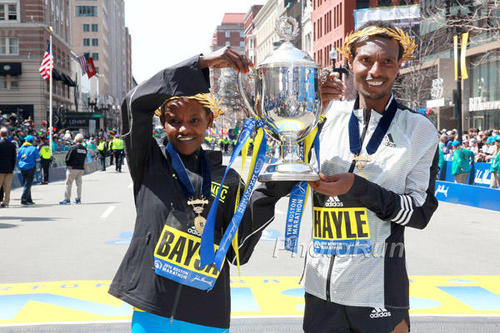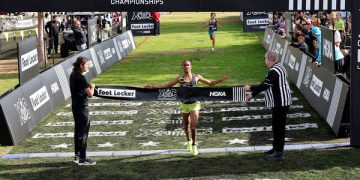It was Saturday night, April 16. LIke most years, on the Saturday of the Boston Marathon Weekend, I spend it with about one hundred of so of my closest friends in the sport at a bar, where we talk about the sport, talk about our lives, do a few toasts, and catch up on the past year.
Many of the conversations brought me back to my early days in Boston. The week long gathering of the sport, from consumer, to elite to business member is constant in Beantown.
How has the sport changed, how has Boston changed? I write this from the coffee shop in London, jet lagged after a long first day at the Guoman Towers hotel.
 Atsede Baysa and Lemi Hayle, photo by PHotoRun.net
Atsede Baysa and Lemi Hayle, photo by PHotoRun.net
When did I first hear about the Boston Marathon? Sometime in my early teens, as I was learning about running, I learnt about the marathon. It was only a bit later that I learnt about the two most important marathons: the Olympic marathon and the Boston Marathon.
In my era, the 1970s-1980s, to qualify in the 20-25 year old age group, I had to run sub 2:51:00 for the marathon, I believe. It took me five marathons to break three hours, and 11 marathons to actually qualify for the Boston Marathon. My first marathon, on the old Paul Mason Winery Marathon course, was 3:29:22. My first sub three hours, was on the Summit Marathon course, where I ran 2:51:18, finishing tenth. That was my fifth marathon.
In my eleventh marathon, I ran 2:48:12, and finally made the qualifying standard for Boston. I hit the halfway in 1:20, and came back in 1:18:12. That would be the best marathon that I ever ran. That was in November 1984.
In 1985, I ran both New York and Boston Marathons, both around 3:23. Forgetting all of my hard won lessons in eleven marathons, I went out way too fast in both events, and was, in all honesty, quite fatigued beforehand, having worked the three day expos at New York and Boston. The twenty mile marks came hard, and I just could not hang on.
Both Boston and New York Marathons are times when the industry gets together, and the combination of expo, race, nights of beverages and running talk, revitalize many.
This year’s Boston was much the same way. Spending a few moments with Bill Rodgers at the Niketown store, we spoke about his hour run American record, and his racing with Ian Stewart at the World Cross, way back in 1975. Runners seldom forget their best races, or their best workouts.
I was recalling for my son and some friends, the late Walt Stack. Stack was a character in running lore in California. A hodcarrier, a member of the Communist Party, Walt ran marathons in a mood of pure delight. He ran about 5 to six hours most times, and had a six pack of Heinecken left on the course for his proper rehydration.
My remembrances of Boston and New York are some thirty to thirty-one years ago. The expo for the New York marathon was in the Shereton hotel basement, I believe. The Boston Marathon expo was the first year of the professional races, had the running community concerned. Would money hurt the sport?
Money has changed the sport, that is sure, whether money has hurt the sport is an entirely other question.
In Boston, John Hancock and adidas, two of the longest reigning sponsors, have added onto their original contracts. Early in the John Hancock days, David D’Alessandro noted that for “3 Million dollars, I own the city of Boston for one day.”
The adidas sponsorship is part of the most well known apparel branding in the world of running. Now that ASICS sponsorship of NYC marathon is about to end, the adidas sponsorship of Boston is one of the most enduring. The Boston marathon jackets are everywhere. While adidas may have given up signage all over Boston, New Balance now controls all of the outdoor in Boston. But, adidas, as I note, has the souls. The iconic nature of the Boston apparel should show adidas that they could promote Boston all year round.
The recent battle for the New York City marathon rights included bids from seven brands. Finally, New Balance, the only major footwear brand without a marathon sponsorship, won the NYC bid. Marathons provide local economic benefits, long time charity benefits, and a showcase for brands to promote to current and future runners.
Two experiences brought home to me the importance of these marathons.
The night of Boston, April 18, I was sitting at the bar in Charlesmark Hotel, listening to an interchange between a runner from Puerto Rico and Jefferson, the bartender. The runner from Puerto Rico was running Boston for the first time since 1996, “the Boston Centennial”. She spoke eloquently on how important the race was and why she came back, to do honor to a cancer patient, a friend, who had won the battle. Jefferson spoke, that most years, he can be found at bar on marathon night, serving the last runner of the night, and buying a beer or wine for many of the runners who finished. He seems to be energized, even though the twenty hours he spends up that day wears him out.
I was touched, not only by Jefferson’s observations, but also his respect for the marathoners, and the event. Someone had tried to explain to me that night that Boston pre 2013 and post are two different races. I disagree.
The goal of the terrorist is to destroy culture, systems and feelings that celebrate the diversity of spirit, body types and beliefs engendered by the Boston Marathon.
Security has been upgraded. There are alot more police, security and lines. But, that is more the sign of the times. A diverse society does not dictate behaviours of someone who listens to another drummer, a diverse society celebrates the eccentricities as ways of showing that culture’s success.
But, has the race been changed, are their two different eras? I do not believe so.
I observe people taking more time with each other. I notice myself greeting each officer as I cross from the Charlesmark to the Lennox for breakfast. It is through tiny, random acts of kindess that much of the hatred is diminished.
The final act reinforced the importance of the marathon to me. At the press conference on Monday, Atsede Bayse gave her award to Roberta Gibbs, the first woman to run Boston in 1966. Baysa decided to give the huge award to Roberta on Monday night, but Jack Fleming of the BAA, wanted Baysa to sleep on it.
Roberta was obviously overcome when she was given the tropy. A huge smile came over Atsede’s face, and she lit up. It was an act of kindness from women five thousand miles apart, and even more apart in their cultural upbringing.
As I filmed a short report on the event with my son, Adam, I had to consciously stop myself from tearing up. We do so much on auto pilot, that we forget how special human kindess can be.
And for the 120th Boston marathon, human kindess happened many places, but for me, at the Charlesmark Hotel by a bartender named Jefferson, and in the Fairmont Copley Plaza Hotel, as the new women’s winner celebrated the 26.2 miles of running by a women from fifty years in the past.
Author

Larry Eder has had a 52-year involvement in the sport of athletics. Larry has experienced the sport as an athlete, coach, magazine publisher, and now, journalist and blogger. His first article, on Don Bowden, America's first sub-4 minute miler, was published in RW in 1983. Larry has published several magazines on athletics, from American Athletics to the U.S. version of Spikes magazine. He currently manages the content and marketing development of the RunningNetwork, The Shoe Addicts, and RunBlogRun. Of RunBlogRun, his daily pilgrimage with the sport, Larry says: "I have to admit, I love traveling to far away meets, writing about the sport I love, and the athletes I respect, for my readers at runblogrun.com, the most of anything I have ever done, except, maybe running itself." Also does some updates for BBC Sports at key events, which he truly enjoys. Theme song: Greg Allman, " I'm no Angel."
View all posts




















